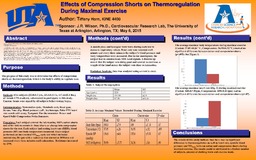
ATTENTION: The works hosted here are being migrated to a new repository that will consolidate resources, improve discoverability, and better show UTA's research impact on the global community. We will update authors as the migration progresses. Please see MavMatrix for more information.
Show simple item record
| dc.contributor.author | Horn, Tiffany | |
| dc.date.accessioned | 2017-04-25T20:18:11Z | |
| dc.date.available | 2017-04-25T20:18:11Z | |
| dc.date.issued | 2015 | |
| dc.identifier.uri | http://hdl.handle.net/10106/26626 | |
| dc.description | KINE 4400 | en_us |
| dc.description.abstract | INTRODUCTION: In response to exercise, heart rate, systolic blood pressure, breathing rate, oxygen consumption and body temperature increase. Since the body is homoeothermic and attempts to remain in a
narrow range of temperatures, the body attempts to regulate the temperature during exercise. Clothing insulates the body and reduces evaporation which is the main process of heat loss during exercise. Clothing
fabrics such as compression have been advertised to promote cooling, improve performance and result in a faster recovery.
PURPOSE: The purpose of this study was to determine if wearing compression shorts during maximal exercise effects the body’s ability to regulate temperature.
METHODS: Five subjects (22.8±1.3 yrs., 63.4±1.14 in, 147.6±22.1 lbs.), all female UTA students, volunteered to participate in this study. Each subject had resting heart rate (RHR), blood pressure (BP) and body
temperature measured. Each subject performed an incremental maximal oxygen consumption (VO2max) cycle test which included maintaining 50 rpm with a resistance that started at 50Watts and increased every
three minutes until exhaustion. A mouth piece and headgear were worn during each test to measure respiratory values. Heart rate (HR) was recorded each minute from a chest strap and every three minutes the
subject’s blood pressure (BP) and body temperature (T) were measured.
RESULTS: The maximal values: T (cotton: 26.96 ±3.73 °C; compression: 26.36 ±3.6 °C); HR (cotton: 168.4 (±7.92) bpm; compression: 169 (±11.81) bpm); SBP (cotton: 136.8 ±4.60 mmHg; compression: 135.6
±5.18 mmHg); VO2 (cotton: 26.96 ±3.73 ml/kg/min; compression: 26.36 ±3.60 ml/kg/min) were not significantly different between cotton and compression shorts (p>0.05).
CONCLUSION: The results of the study indicate that there was no significant difference between the body’s ability to regulate core temperature during maximal exercise which was measured by body temperature.
The results could be attributed to a limited number of participants, human error, and mode of exercise. | en_US |
| dc.description.sponsorship | Faculty Sponsor, J.R. Wilson | en_US |
| dc.language.iso | en_US | en_US |
| dc.subject | Heart rate | en_US |
| dc.subject | Maximal oxygen consumption | en_US |
| dc.subject | Thermoregulation | en_US |
| dc.title | Effects of Compression Shorts on Thermoregulation During Maximal Exercise | en_US |
| dc.type | Presentation | en_US |
| dc.publisher.department | Department of Kinesiology, The University of Texas at Arlington | en_us |
| dc.publisher.department | Cardiovascular Research Lab, The University of
Texas at Arlington | en_us |
| dc.publisher.department | Exercise Science Research Laboratories, The University of Texas at Arlington | en_us |
Files in this item
- Name:
- Horn T.pdf
- Size:
- 544.4Kb
- Format:
- PDF
- Description:
- PDF
This item appears in the following Collection(s)
Show simple item record


